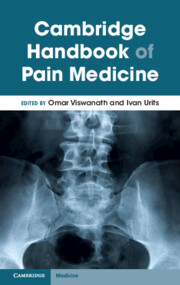Book contents
- Cambridge Handbook of Pain Medicine
- Cambridge Handbook of Pain Medicine
- Copyright page
- Contents
- Contributors
- Pain Handbook Introduction
- Part I Introduction to Pain: Pain Signaling Pathways
- Part II Common Categories of Pharmacologic Medications to Treat Chronic Pain
- Chapter 4 Nonsteroidal Anti-inflammatory Drugs (NSAIDs)
- Chapter 5 Acetaminophen
- Chapter 6 Topicals
- Chapter 7 Muscle Relaxants
- Chapter 8 Opioids
- Chapter 9 Antineuropathic Medications
- Chapter 10 Cannabinoids
- Part III Chronic Pain Conditions Head and Neck
- Part IV Spine
- Part V Extremities
- Part VI Misc
- Part VII Adjunctive Therapy
- Index
- References
Chapter 8 - Opioids
from Part II - Common Categories of Pharmacologic Medications to Treat Chronic Pain
Published online by Cambridge University Press: 01 December 2023
- Cambridge Handbook of Pain Medicine
- Cambridge Handbook of Pain Medicine
- Copyright page
- Contents
- Contributors
- Pain Handbook Introduction
- Part I Introduction to Pain: Pain Signaling Pathways
- Part II Common Categories of Pharmacologic Medications to Treat Chronic Pain
- Chapter 4 Nonsteroidal Anti-inflammatory Drugs (NSAIDs)
- Chapter 5 Acetaminophen
- Chapter 6 Topicals
- Chapter 7 Muscle Relaxants
- Chapter 8 Opioids
- Chapter 9 Antineuropathic Medications
- Chapter 10 Cannabinoids
- Part III Chronic Pain Conditions Head and Neck
- Part IV Spine
- Part V Extremities
- Part VI Misc
- Part VII Adjunctive Therapy
- Index
- References
Summary
A class of analgesics structurally similar to the natural alkaloids derived from the resin of the opium poppy. Natural alkaloids are known as opiates and they include morphine and other similarly structured drugs, such as codeine, hydrocodone, and oxycodone. Synthetic derivates include hydromorphone, fentanyl, and heroin, among others (3). Three opiate receptors – µ, ?, and d – were found predominantly in the CNS. Most analgesic effect of opioids is mediated by the µ receptor. Decrease presynaptic calcium influx and increase postsynaptic potassium efflux, leading to inhibition of neuronal firing and neurotransmitter release.
- Type
- Chapter
- Information
- Cambridge Handbook of Pain Medicine , pp. 58 - 60Publisher: Cambridge University PressPrint publication year: 2023

